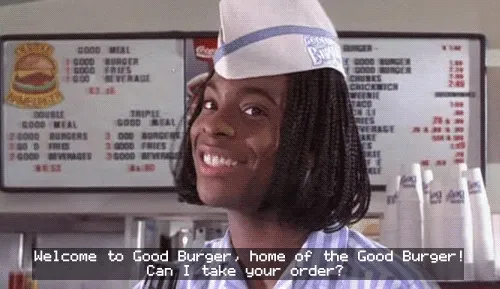21 terms to sound like a restaurant insider
In QSRs, FSRs, and more, workers have their own language. Allow us to translate.

Good Burger/Nickelodeon via Giphy
• 4 min read
In a glowing review of Jennifer Close’s new novel, Marrying the Ketchups, the New York Times gave plenty of plot summary, but it didn’t get around to explaining the title. Close herself, however, in a YouTube video, explained that the title has turned out to be a sort of Rorschach test.
“One of the funny things that happens when people ask me what my new book is called, and I tell them, Marrying the Ketchups, is that they either smile knowingly at me, or they look at me confused and ask me to repeat it,” Close said in the video. “And from that reaction, I can tell who has worked in a restaurant—and who has not.”
- For the uninitiated, Close proceeds to demonstrate the term, which is when staff collect all the ketchup bottles from the tables and combine them so that, say, 24 partially filled bottles become 10 filled ones.
- It’s a common end-of-shift task, commonly called—here’s another term—side work.
Marrying condiments may make some restaurant-goers squeamish and inspire SNL writers, but it also highlights the colorful and mysterious language of the restaurant trade. Here at Retail Brew, it’s QSR Month, which, maybe you didn’t know—no shame, we’re all friends here—stands for a quick-service restaurant, as opposed to FSR (full-service restaurant).
Before we serve you up more restaurant-related stories in the coming weeks, here are some terms peculiar to the trade.
86: The way workers are told an item has run out, so they know to warn customers that it’s not on the menu. Etymology is a mystery, although theories abound. 86 the shrimp.
Bev nap: Small square bar napkins, the kind on which randy singles write down their phone numbers in movies.
The boogie man: A term of non-endearment (enfearment?) for the health inspector.
Back of house (BOH): The area beyond the dining room where the kitchen staff works. This area was largely unseen in earlier eras, but is now increasingly visible with the popularity of open-kitchen designs.
Camper: A diner who occupies a table longer than the server or management might like. (See Turn.)
Retail news that keeps industry pros in the know
Retail Brew delivers the latest retail industry news and insights surrounding marketing, DTC, and e-commerce to keep leaders and decision-makers up to date.
Clopen: A portmanteau of close and open, meaning working a closing dinner shift and then an opening breakfast or lunch shift the following day. Not exclusive to restaurant workers, but can be particularly onerous to them when kitchens are open late.
Daypart: The time of day for a menu offering, typically breakfast, lunch, and dinner, and increasingly expanding into late-night snacking, as Taco Bell famously did with its “Fourthmeal” campaign.
Double: Working back-to-back shifts, such as breakfast and lunch or lunch and dinner.
Front of house (FOH): The dining area and bar.
Ghost kitchen: A delivery-only kitchen, either by upstarts trying to limit overhead or existing restaurants looking to expand their delivery capacity.
High top: Taller tables, often in bar and lounge areas.
In the weeds: The sheer terror when too busy, as when Grubhub orders are stacked up and there’s a line at the register.
Joiner: A late arrival at a table that has already been seated, and the reason the server left that fourth setting on the table when you said yes, someone else would be joining you.
Kitchen display system (KDS): An automated, paperless ordering system that is increasingly replacing older systems of orders printed out on tickets in kitchens.
Monkey bowl: A small flat-bottom bowl common in restaurants, often used for a small side of sauce or condiment. (See SOS.) Its origin is unknown, but even the theories seem like a stretch.
Rollup: Also called a setup, it’s cutlery (stainless steel or plastic) rolled up in a napkin (cloth or paper), often a server’s end-of-shift side work.
SOS: Sauce on the side.
Table tent: A self-standing, often A-frame shaped sign on a table that promotes specials.
Turn: “Turning a table” means getting one party out to clear the way for another party. When wait-lists get long, a server might be urged to “turn and burn” a party, meaning to try to get them out without, of course, seeming rude.
Two-top, four-top, etc.: The size of a seated party.
Walk-in: Short for walk-in refrigerator or walk-in freezer.
Retail news that keeps industry pros in the know
Retail Brew delivers the latest retail industry news and insights surrounding marketing, DTC, and e-commerce to keep leaders and decision-makers up to date.